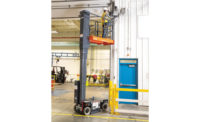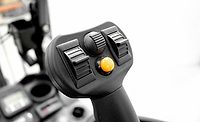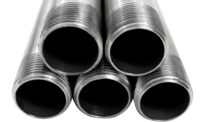The buzzwords “sustainability” and “efficiency” have permeated all aspects of business. Not-so-surprisingly, the phrases also are hot topics for companies when they make decisions about lift trucks, according to New Bremen, Ohio-based Crown Equipment Corp. Its “Forklift User Survey” found that 83 percent of respondents think sustainability is important when making lift truck purchasing decisions, while energy efficiency was highlighted by 95 percent of survey-takers.
Crown Equipment’s survey also found that 51 percent of respondents increased the size of their fleets in the three years before summer 2011. In the same time period, fewer than 10 percent reduced their fleets, it found. Looking forward, 50 percent of survey-takers expect that their fleets will stay the same size and 47 percent anticipate that their fleet size will grow by 2014.
Respondents to Crown Equipment’s survey showed a strong interest in emerging technologies such as fuel cells and fleet management for lift trucks. More than one-third believes fuel cells will be important to material handling in the next five years. Some form of fleet management software is used by 37 percent of respondents; although within that group, 65 percent indicated that they use spreadsheets as a lift truck fleet management tool, Crown Equipment’s survey showed.
“Our customers are interested in new and innovative ways to minimize waste, manage energy and maximize productivity,” said Matt Logan, director of global marketing for Crown Equipment, in a November statement. “These three principles are embedded in our product development, engineering, design, manufacturing and operational processes so that we can deliver the sustainability and efficiency the market is demanding.”
Knowledge is power
Helping those 47 percent of Crown Equipment survey respondents who are looking to grow their lift truck fleets in the coming years are various assets and tools. Crown Equipment’s Jim Gaskell, director of global Insite products, participated in a fleet management roundtable discussion at Interlog 2012 in June in Dallas. During the discussion, Gaskell highlighted how recent advances in warehouse management technology offer manageable ways for companies to reap varied benefits from the information available from their forklift fleets. Coherent organization of forklift data is key to optimizing material handling operations and also is essential to addressing productivity, efficiency and compliance issues in many applications, he noted.
“Concerns about the cost and complexity of implementing a comprehensive forklift fleet and operator management program have kept some organizations from moving forward with deployment,” Gaskell said in a pre-show statement. “The key to implementing an effective fleet and operator management system is utilizing reliable, scalable and flexible technology that enables a phased approach. As a leader in material handling technology, Crown is committed to providing customers with a comprehensive and practical roadmap that enables them to effectively manage the movement of their fleet, operators and products.”
Available in front-mount or side-mount options, the Tygard Claw is designed to offer efficiency in layer picking, according to Tygard Machine & Manufacturing, Washington, Pa. The front-mount option is able to split pallet loads or remove excess layers, allowing cubes to fit in racks and full loads to be split in half, it notes. Lifting layers quickly to build mixed pallet loads is the goal of the side-mount Tygard Claw, which the company says is well suited for distribution facilities.
Houston-based Cat Lift Trucks, a division of Mitsubishi Caterpillar Forklift America Inc. (MCFA), developed its Lift Truck Cost Comparison Tool, which is a free Web resource. The online tool helps customers evaluate the total cost differentiation between electric alternating current (AC) and internal combustion (IC) lift trucks.
Available on Cat Lift Trucks’ website, the tool uses a calculator to factor in a lift truck’s total cost of ownership, including acquisition costs, fuel costs and maintenance to show the return on investment for customers, the company says. Users answer questions about their company’s lift truck application, existing lift truck fleet, electric alternative options, and fuel and maintenance costs to arrive at a cost comparison that can be emailed or downloaded.
Toyota Material Handling U.S.A. Inc., Irvine, Calif., launched its Toyota Forklift Fuel Efficiency Calculator application to help users estimate fuel efficiency savings and performance for forklift fleets in January. The interactive tool is available on the company’s website or as a free app for iPhones, iPads, smartphones and Android tablets, the company says. Users are able to enter their detailed material handling specifications, and the app’s calculator will measure a number of user-specific variables including fuel efficiency as well as run times and speed advantage per cycle, the company says.
Next and now
Fitting into the increased demand for electric lift trucks, MCFA subsidiary Mitsubishi Forklift Trucks announced the new FB16PNT-FB20PNT series of forklifts. The series of three-wheel forklifts have a compact design and are equipped with wet disc brakes for improved performance in wet or corrosive environments. They also feature electric power steering that provides improved energy efficiencies and an ergonomic operator compartment, according to the company. In addition to heavy-duty AC drive and hydraulic motors, the series also is equipped with the company’s Controlled Cornering Speed feature that progressively reduces the speed of the forklift as the truck’s steer angle increases, it explains. This offers additional control for both the operator and load, according to Mitsubishi Forklift Trucks.
Also designed with AC technology, Cat Lift Trucks introduced the 2EPC5000-2EP6500 series electric pneumatic tire lift trucks with 5,000- and 6,500-pound capacities. The series was designed to have improved energy efficiency, industry-leading performance levels and premium operator ergonomics, the company says. The durable 80-volt electric pneumatic lift trucks were designed to deliver performance similar to — or better than — an IC lift truck, Cat Lift Trucks explains. The series was designed to run as many as two shifts on one battery change in most applications and also features a 10 percent increase in energy efficiency compared to the previous generation, according to the company.
The Raymond Corp., Greene, N.Y., debuted its 8000 Series pallet trucks in May. Designed to move more product in less time, Raymond’s 8000 Series pallet trucks have a number of user-friendly features such as roomy operator compartments with padding and multiple lean points, accessory bars with lights and fans, large storage totes and additional caster options, the company says.
“The Raymond 8000 Series was built with one thing in mind: the customer,” said Sue Rice, pallet trucks and stackers product manager for Raymond, in a statement. “This line of pallet trucks was intelligently designed to exceed the performance expectations of our customers — from durability and productivity to ease of maintenance and low cost of ownership. At Raymond, we call this Eco-Performance: a commitment to continuously improve to help customers maximize productivity and efficiency, minimize cost of ownership and operate more sustainably.”
In May, Utilev, Greenville, N.C., introduced its range of UT25-30P diesel and LPG fuel forklift trucks in select U.S. markets. Available in 5,000- and 6,000-pound capacities, Utilev lift trucks are designed for users across many industries that require material handling equipment without advanced functionality. Utilev lift trucks are available for light- to medium-duty operating environments in which customers use lift trucks intermittently during the day or week. Its models also are designed to be easy to operate and service, it notes.
Nissan Forklift Corp. highlighted its 2011 developments including several new product releases. Last year, the Marengo, Ill.-based company launched the Platinum GO6 series of pneumatic lift trucks with efficient diesel engines, the Platinum OP series of order picker trucks with Ergolift, the APX series of walkie pallet trucks designed for maneuverability in tight spaces and the Trucker’s Special that was specifically designed to make loading and unloading trucks more efficient, according to the company.
The company also added the QX Series to its Platinum family of electric lift trucks. Featuring four models ranging from 4,000- to 6,000-pound capacities, the series uses 80-volt AC power for fast travel and lift speeds with lower operating costs than comparably sized engine-powered forklifts, Nissan explains. The series also features a tight turning radius for enhanced maneuverability and a low center of gravity, it adds. In addition, the trucks have a standard regenerative braking system to reduce power consumption, which Nissan notes allows for longer operating hours.
Height advantage
With the increase in warehouse designs that take advantage of vertical space, lift truck manufacturers have launched options that rise to the challenge. Ergolift, a feature designed to reduce operator stress and increase overall productivity, is available on Nissan’s Platinum OP series order picker models. A secondary mast on the fork carriage is incorporated into Ergolift trucks to allow the operator to raise and lower the pallet to comfortable heights while stacking and retrieving, the company says. The Platinum OP models, which are offered with the choice of nine mast heights and capacities up to 2,200 pounds, also provide dual-control pods that allow simultaneous drive and lift/lower functions.
A division of NACCO Materials Handling Group Inc., Cleveland-based Hyster Co. launched a new series of AC-powered OrderPickers last October. The upgraded series has lifting capacities between 1,500 and 3,000 pounds and includes a heavy duty counterbalanced R30CM3 with travel speeds as fast as 6.5 mph, a standard duty counterbalanced R30XMS3 and a R30XMA3 straddle selector, according to the Greenville, N.C.-based company.
“The series showcases our improved HySense Continuous Height Sensing control system,” said Jonathan Dawley, president of Hyster Distribution, in a statement. “The updated HySense technology provides smooth, gradual linear speed reduction that is barely noticeable to operators. The result is a more refined braking action while traveling at extended heights, bolstering confidence and therefore productivity, which is the bottom line for our customers’ business.”
Crown Equipment introduced its line of Crown TSP 7000 and TSP 6500 Series Turret Trucks featuring its MonoLift mast design, which is offset from the driver for better visibility, it notes. The Crown TSP Series was designed to provide faster lift, travel, pivot and traverse speeds with a main lift speed of 120 feet a minute, the company notes. In addition, the models provide users with greater flexibility throughout their warehouses by being able to place most loads at any height or at any open slot while traveling in narrow aisles with less than 6 inches of clearance, according to Crown. The TSP 6500 is able to reach 531 inches and the TSP 7000 turret truck can extend to a total of 675 inches and deliver most loads to a full height. The models also use regenerative braking and lowering systems that capture lost energy and return it to the battery, the company notes.
Also equipped with the Crown MonoLift mast design is the 42-inch chassis option in its RM 6000 Series of reach trucks. The updated model is able to reach 400 inches while delivering as much as 1,000 pounds more capacity at full height, the company notes. The RM 6000 mast design uses one fewer cylinder than conventional mast trucks and protects the cylinders by locating them near the center of the truck, which minimizes contact with racking by more than
50 percent, it notes. The model also is the latest forklift to be included in Crown’s fuel cell qualification program. The fuel cell-powered Crown RM 6000 features fuel cell controls and gauges that are integrated into the truck dashboard and offers programmable performance settings and advanced diagnostics, Crown explains.
MCFA division Jungheinrich introduced its EKX 410 man-up turret truck in May. The forklift is designed to operate exclusively in narrow aisles and can be used for full pallet put-away and retrieval as well as picking individual items, the company says. The updated model features increased lift heights of more than 30 feet and improved residual capacities compared with the previous option, it adds. The EKX 410 turret truck is equipped with 48-volt fourth-generation AC technology and, according to the company, uses advanced regenerative braking and lowering that allows reclaimed energy to return to the battery in order to reduce the amount of downtime needed for charging.
Jungheinrich also added the EKS 208 and 308 series of mid- to high-level order pickers that offers a range of voltage and capacity configurations.
“With the new Jungheinrich EKS 208 and EKS 308 order pickers, customers now have the ability to choose the configuration that best meets their specific order picking needs,” said Ross VanderLaan, manager of corporate planning and product management at MCFA, in a statement. “The narrow chassis design and high lift heights are just a few of the core features that make their product ideal for customers requiring exceptional picking performance in high-rack warehouse applications.”
Designed to provide flexibility in very narrow or wide aisles, the EKS 208 has a narrow chassis and is available in 24-volt and 48-volt configurations with load capacities of up to 2,200 pounds. The EKS 308 can accommodate order picking as high as 402 inches with load capacities as heavy as 3,000 pounds. It is available in 24-, 36- and 48-volt options, the company says.
Also available from Jungheinrich is the ETV/ETM 214/216 series sit-down moving-mast reach trucks. Launched late last year, the series is suitable for both narrow aisle and high-rack applications that require rapid maneuverability, the company says. The series is one of the few sit-down moving-mast reach trucks offered in North America that allows operators to remain seated while driving, it explains. The trucks also can be equipped with optional Drive Plus and Lift Plus features that increase drive speeds by nearly 2 mph and loaded lift speeds by more than 30 feet a minute, Jungheinrich says.
Rigorous endurance
Yale Materials Handling Corp., a division of NACCO Materials Handling Group Inc., developed its heavy-duty MPE060-080VG end-rider pallet trucks for cold storage application needs. The model has been tested in extreme operating conditions and has a capacity between 6,000 and 8,000 pounds. The test included more than 1,000 hours of operation in extreme cold storage before needing service with the following results: more than 1,300 trailers emptied, in excess of 50,000 pallets moved, more than 30,000 dock plates hits, 100,000 lifts and lowers, 105 million pounds of freight lifted and transported, and more than 3,000 miles traveled, according to the company.
Yale also offers a galvanized version of the MPE060-080VG with a heavy corrosion/wash-down package that was designed to protect the truck from wet and highly corrosive environments, such as those found in some food processing environments, the company notes.
Toyota Material Handling also released a galvanized chassis for three models of its AC electric pallet truck and walkie riders. The following models are available with galvanized chassis options to protect the vehicles while operating in wet environments: the 8-Series
AC electric walkie pallet truck with 6,000- pound capacity, the 8-Series end-control walkie rider with between 6,000- and 8,000-pound capacity, and the 7-Series electric walkie pallet truck that has a 4,500- pound capacity, the company says.
Last year, Toyota Material Handling added a compact 27-inch battery compartment option to its 8-Series 4-wheel AC electric lift trucks with 4,000- and 5,000-pound load capacities. With a short design that can accommodate either a 36- or 48-volt battery, the compartment enables the lift truck to maneuver in 12-foot aisles, the company says. The option is suited for a range of indoor material handling needs including beverage applications that have tight turning radius requirements while still offering peak capacities at high lift heights, Toyota Material Handling says. BI






